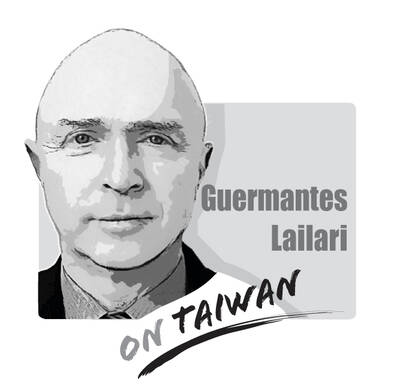Real-estate prices have continued to go through the roof, as the property market remains bullish. Statistics released by the Ministry of the Interior showed that 3.15 million properties exchanged hands last year, rising by 21,605, or 6.62 percent, from the previous year, prompting the ministry to introduce amendments to crack down on speculation.
Investing in the housing market has become just a dream, because selling property can be heartrending, and anyone currently sitting on a property, using it as their home and waiting for a time when prices would rise to sell it would be waiting for a long time, Cushman & Wakefield Taiwan general manager Billy Yen (顏炳立) has said.
I could not agree more with this assessment: The following two metrics suggest that we are sitting in a housing bubble that could burst at any time.
First, for the past two years, mortgages accounted for more than 40 percent of GDP — a ratio internationally recognized as a warning sign of a housing bubble.
Data from the central bank and the Directorate-General of Budget, Accounting and Statistics (DGBAS) showed that in December 2020, home mortgages totaled more than NT$8 trillion (US$286.8 billion at the current exchange rate), which was 40.64 percent of that year’s GDP of about NT$19.8 trillion.
Adding in construction loans of just under NT$2.5 trillion would raise the total amount of loans to about NT$10.5 trillion, accounting for 53.07 percent of GDP.
Despite the central bank’s implementation of selective credit-control measures, home mortgages climbed to more than NT$8.8 trillion in December last year, accounting for 40.66 percent of that year’s GDP of NT$21.65 trillion.
Again, adding in construction loans of more than NT$2.8 trillion, total loans would be NT$11.6 trillion, or 53.63 percent of GDP.
Central bank Governor Yang Chin-long’s (楊金龍) concern over surging property loans is understandable, including why he decided to expand selective credit controls.
The second factor is housing supply continues to rise, while the population is falling. A DGBAS population and housing survey for 2020 showed a record number of vacant homes of 1.66 million.
Ministry figures showed that 104,872 residential building permits and 170,465 construction permits were issued last year for a total of 275,337. If this is multiplied by the average of 2.88 people per family, as per the ministry’s calculations, the new housings could accommodate more than 792,000 people. This figure does not even include the 98,260 housing permits issued in 2020.
When the population is falling and there is a housing surplus, what is left is a housing bubble.
The housing market has had its ups and downs: In the late 1980s, when the stock market was booming, housing prices soared. However, when the housing market collapsed in the late 1990s, homeowners were left unable to pay their mortgages, leading to a massive number of properties being placed under the hammer for horribly low bids.
My house in Nantou County is next to a congregate housing complex built in the 1990s, when it sold for NT$100,000 per ping (3.3m2); in the early 2000s, a considerable number of these properties were put up for auction, fetching only NT$30,000 per ping.
This should come as a warning for anyone thinking of purchasing a house in the current climate.
Wang Juei-hsing is a former head of the Taiwan Provincial Government’s Land Development Division.
Translated by Paul Cooper

Chinese state-owned companies COSCO Shipping Corporation and China Merchants have a 30 percent stake in Kaohsiung Port’s Kao Ming Container Terminal (Terminal No. 6) and COSCO leases Berths 65 and 66. It is extremely dangerous to allow Chinese companies or state-owned companies to operate critical infrastructure. Deterrence theorists are familiar with the concepts of deterrence “by punishment” and “by denial.” Deterrence by punishment threatens an aggressor with prohibitive costs (like retaliation or sanctions) that outweigh the benefits of their action, while deterrence by denial aims to make an attack so difficult that it becomes pointless. Elbridge Colby, currently serving as the Under
The Ministry of the Interior on Thursday last week said it ordered Internet service providers to block access to Chinese social media platform Xiaohongshu (小紅書, also known as RedNote in English) for a year, citing security risks and more than 1,700 alleged fraud cases on the platform since last year. The order took effect immediately, abruptly affecting more than 3 million users in Taiwan, and sparked discussions among politicians, online influencers and the public. The platform is often described as China’s version of Instagram or Pinterest, combining visual social media with e-commerce, and its users are predominantly young urban women,
Most Hong Kongers ignored the elections for its Legislative Council (LegCo) in 2021 and did so once again on Sunday. Unlike in 2021, moderate democrats who pledged their allegiance to Beijing were absent from the ballots this year. The electoral system overhaul is apparent revenge by Beijing for the democracy movement. On Sunday, the Hong Kong “patriots-only” election of the LegCo had a record-low turnout in the five geographical constituencies, with only 1.3 million people casting their ballots on the only seats that most Hong Kongers are eligible to vote for. Blank and invalid votes were up 50 percent from the previous
Japanese Prime Minister Sanae Takaichi lit a fuse the moment she declared that trouble for Taiwan means trouble for Japan. Beijing roared, Tokyo braced and like a plot twist nobody expected that early in the story, US President Donald Trump suddenly picked up the phone to talk to her. For a man who normally prefers to keep Asia guessing, the move itself was striking. What followed was even more intriguing. No one outside the room knows the exact phrasing, the tone or the diplomatic eyebrow raises exchanged, but the broad takeaway circulating among people familiar with the call was this: Trump did